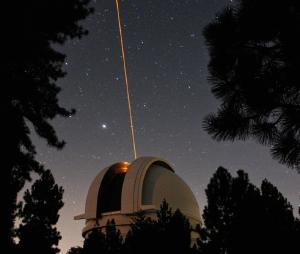Post
Adaptation
27 May 2013
 Palomar/Caltech
Palomar/CaltechIf you’ve ever looked up in the night sky you’ve seen the twinkling of the stars. This twinkle is not due to the stars themselves, but to the turbulent motion of the Earth’s atmosphere. As starlight enters our atmosphere, the variations in density in turbulent air cause the light wave fronts to distort. So instead of reaching the telescope evenly like even rows of a band on parade, the wave fronts come in uneven and wobbly. This wobbly behavior is why stars appear to twinkle.
One way to overcome this problem is to simply put your telescope in space. This not only eliminates the twinkle effect, but also allows you to make observations at wavelengths our atmosphere absorbs, such as most of the infrared. The big downside is that space telescopes are very expensive, and their size is fairly limited. The Hubble telescope, for example, has a mirror diameter of about 8 feet. In contrast the Keck telescopes have a diameter of about 32 feet, which means their mirrors have about 16 times the area of the Hubble. Because of the cost, there are also only a handful of optical space telescopes, while there are dozens of large ground-based telescopes.
There is a way that you can minimize the twinkling effect for ground-based telescopes, and it’s known as adaptive optics. The basic idea is to correct for the wave distortion by adjusting the mirror in real time to account for it. The main way this is done is by using a tip-tilt mirror to realign the image, or if the mirror is segmented (as many modern large telescopes are), adjust each segment to correct for the distortion.
Of course to make this correction you have to be able to distinguish between distortion caused by the air and any real variance in what you are observing. There are a couple of ways this can be done. If what you are observing has a fairly bright star in your field of view, then you can adjust the mirrors to keep that particular star in perfect focus. By accounting for the distortion of the bright star you account for the distortion in your image.
But often what you are observing doesn’t have a sufficiently bright star in your field of view. In this case you can use a laser to simulate a star. You can see this trick being used with a sodium laser in the image above. The laser itself is not particularly bright, but there are small amounts of sodium atoms about 60 miles up, and the laser excites them, causing them to glow. Since the glowing atoms are in the telescope’s field of view, it looks like a star. And since 60 miles is higher than most of the Earth’s atmosphere, the distortion of the sodium’s glow is about the same as the distortion of star light. So by keeping your artificial star in focus you can keep your image in focus.
With adaptive optics and a simulated star ground-based telescopes can obtain images that rival those of a space telescope.